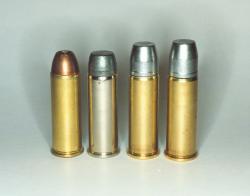GARRETT 44 MAGNUM AMMO
Central to our efforts in 44 Magnum is the generation of the most power possible per unit of chamber pressure. Unfortunately, conventional 44 Magnum bullets provide substantial barriers to the production of maximum power within safe pressure limits. Standard overall cartridge length for the 44 Magnum, as defined by SAAMI, is 1.60-inches. This allows the use of such cartridges in a variety of firearms such as lever-action rifles and clip-fed autos, as well as revolvers. However, adhering to this overall length substantially reduces the amount of power that can be safely generated from revolvers. Revolvers, by virtue of their long chamber throats, allow the use of longer cartridges than can be used in other firearm types. In response to this, we have designed our bullets to move weight forward, thus utilizing the long chamber throats of the revolver as storage areas, as opposed to their normal function as empty pre-barrel pathways. This is the defining characteristic of our long weight-forward Hammerheads, which exhibit long noses and unusually short bullet bases, resulting in increased gunpowder capacity in the cartridge case. By so doing, we are able to generate more power than can be safely generated by using conventional bullets, with their characteristic short noses and long bases. An inspection of the loaded revolver clearly demonstrates our weight-forward approach, as our long bullet noses dramatically fill the chamber throats. This is the first element of superiority of our Hammerhead bullets.
 Cartridges Left to Right: WINCHESTER 250gr, FEDERAL CAST-CORE 300gr, GARRETT 310gr, GARRETT 330gr |
Since wound channel diameter is much more a product of meplat diameter than actual bullet diameter, it is our view that all non-expanding hunting bullets should utilize very broad meplats. Broader meplats result in larger diameter wound channels, which increase the speed of incapacitation. Another benefit of broad meplated bullets is increased penetration depth. This relationship of penetration depth to meplat diameter is quite interesting, and fundamental to proper full-potential bullet design. It is commonly believed that bullets with less meplat diameter, such as truncated cones, offer less resistance to penetration and, therefore, provide deeper penetration. This would be true if terminal stability was not influenced by meplat diameter. However, bullets such as truncated cones with less frontal area, and greater front to back weight disparity, are far less stable upon impact, and, as a consequence, provide less penetration. It is always easier to observe than explain, but clearly as the weight disparity between the front of the bullet and the rear of the bullet increases, there is a tendency for the heavier end to overtake the lighter end upon impact. This takes the form of the rear of the bullet moving forward faster than the front, resulting in yaw which greatly inhibits penetration. Simply stated, the bullet goes sideways. However, when the weight disparity between the front of the bullet and the rear of the bullet is minor, or non-existent, this tendency to yaw is greatly reduced and the bullet penetrates deeper. However, once the issue of front to back weight disparity is corrected, and bullet yaw is substantially eliminated, further increases in meplat diameter result in reduced penetration depth. These facts have led to our choice of .320-inch diameter meplats for our 44 Magnum Hammerheads. Significantly less meplat diameter results in reduced penetration, as does significantly increased meplat diameters.
The third significant characteristic of our 44 Magnum ammo is our special alloy and casting techniques. We designate our bullets as SuperHardCast to differentiate them from common hard cast bullets, as our bullets offer both greater strength, and greater freedom from fracture than common machine-cast commercial bullets. Bullet hardness is an important factor in bullet strength, but if not properly managed can cause bullets to fracture when their inherent strength is exceeded. Common to machine cast commercial cast bullets is the use of high antimony alloy. This is used as it provides an acceptable rejection rate, as utilized in automatic casting machines. Unfortunately, however, high antimony alloys tend to fracture when stressed beyond their inherent strength, as in point blank impact into the toughest game. I find this to be unacceptable for bullets that might be used against heavy or dangerous game. Consequently, our alloy is very low in antimony, about 2.5% as opposed to the common 6-12% of popular commercial alloys. Our alloy yields a bullet that is very hard, but will deform modestly when stressed beyond its inherent strength. Commonly, our 44 Magnum Hammerheads will shoot through broadside elk, even when the shoulders are engaged, or penetrate to the hips on frontally shot grizzly. They will also shoot lengthwise through heavy deer and boar, allowing bad-angle shots, as when the game is going away from the shooter.
Our SuperHardCast 44 Magnum Hammerheads are the result of an unusually comprehensive approach to ammo building. By designing our own super efficient weight-forward bullets, we are able to achieve more power per unit of chamber pressure than can be achieved using conventional designs. Our weight-forward Hammerheads are also target-accurate, delivering 1-inch groups at 50-yards from accurate revolvers. Also, our .320-inch meplats offer the best in wound channel diameter, penetration, and quick anchoring of game. Finally, our special alloy, bullet hardening, and careful hand-casting provides completely reliable performance against the heaviest game, where bullet impact stresses are the greatest. Our 44 Magnum Hammerhead Ammo is simply without peer in the realm of big game 44 Magnum hunting loads.
- Randy Garrett

